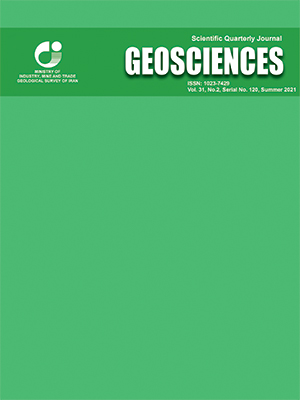Document Type : Original Research Paper
Authors
1 Associate Professor, Research Institute for Earth Sciences, Geological Survey of Iran
2 M.Sc. Student of Research institute for Earth Sciences, Geological Survey of Iran
3 Professor, Faculty of Earth Sciences, Geological Survey of Iran, Tehran, Iran
Abstract
The Mohr circle is a well-known method for two-dimensional strain analysis. Due to the formation of the boudins during two stages of the progressive deformation (D1 and D4) in cherty marbles, from north Golpaygan metamorphic complex, they have been analyzed for strain in two-dimension. This analysis is based on estimating of the initial length of the boudins before deformation, and measuring the current length of the boudins, after deformation. Calculation of the longitudinal parameters of the strain and drawing Mohr circles show that the strain ratio varies between 1.06 to 2.35 for D1 stage, and between 1.10 to 2.84 for D4 stage. The mean shear angle for the D1 stage is 22 ° and for the D4 stage is 24 °.
Keywords
Main Subjects
Ferguson, C, C., 1981- A strain reversal method for estimating extension from fragmented rigid inclusions. Tectonophysics 79, T43-T52.
doi.org/10.1016/0040-1951(81)90108-6.
Fry, N., 1979-Random point distributions and strain measurement in rocks. Tectonophysics 60, 89–105.
doi.org/10.1016/0040-1951(79)90135-5.
Mandal, N., Dhar, R., Misra, S. and Chakraborty, C., 2007- Use of boudinaged rigid objects as a strain gauge: Insights from analogue and numerical models. Journal of Structural Geology 29, 759-773. doi.org/10.1016/j.jsg.2007.02.007.
Moosavi, E., Mohajjel, M. and Rashidnejad-Omran, N., 2014- Systematic changes in orientation of linear mylonitic fabrics: An example of strain partitioning during transpressional deformation in north Golpaygan, Sanandaj–Sirjan zone, Iran. Journal of Asian Earth Sciences 94, 55-67. doi.org/10.1016/j.jseaes.2014.07.003.
Moritz, R., Ghazban, F. and Brad, S., 2006- Eocene Gold Ore Formation at Muteh, Sanandaj-Sirjan Tectonic Zone, Western Iran: A Result of Late-Stage Extension and Exhumation of Metamorphic Basement Rocks within the Zagros Orogen. Econ. Geol.101, 1497–1524. doi.org/10.2113/gsecongeo.101.8.1497.
Rachidnejad-Omran N., Emami, M. H., Sabzehei, M., Rastad, E., Bellon, H. and Pique, A., 2002- Lithostratigraphie et histoire paléozoïque à paléocène des complexes métamorphiques de la région de Muteh, zone de Sanandaj–Sirjan (Iran méridional). Comptes Rendus Geosciences, 334, 1185-1191. doi.org /10.1016/S1631-0713 (02)01861-8.
Ragan, D. M., 2009- An Introduction to Geometrical Techniques (Fourth edition), Cambridge University Press. 614. ISBN-10: 0521745837.
Ramsay, J. G., 1967- Folding and Fracturing of Rocks. McGraw-Hill, New York, 568. ISBN-10: 193066589X.
Ramsey, J. G. and Huber, M. H., 1983- Modern structural geology, Volume 1: strain analysis. Academic Press, 307. ISBN-10: 0125769016.
Sheikholeslami, M. R., Ghassemi, M. R. and Hassamzadeh, J., 2019- Tectonic evolution of the hinterland of the Zagros Orogen revealed from the deformation of the Golpaygan Metamorphic Complex, Iran. Journal of Asian Earth Sciences, 182, 103929. doi.org/10.1016/j.jseaes.2019.103929.
Talbot, C. and Sokoutis, D., 1995- Strain ellipsoids from incompetent dykes: application to volume loss during mylonitization in the Singo gneiss zone, central Sweden. Journal of Structural Geology, 17, 927-948. doi.org/10.1016/0191-8141(94)00113-E.
Treagus, S. H., 1987- Mohr circles for strain, simplified. Geological Journal, 22, 119 -132. doi.org/10.1002/gj.3350220205.
Verdel, C., Wernicke, B. P., Hassanzadeh, J. and Guest, B., 2011- A Paleogene extensional arc flare-up in Iran. Tectonics 30, TC3008. doi.org/10.1029/2010TC002809.

